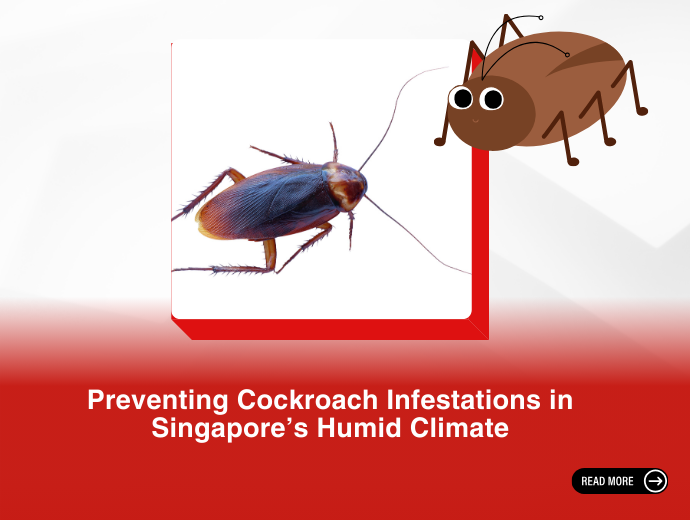Cockroaches thrive in Singapore’s warm and humid climate, making them a persistent challenge even for a professional pest control company. These pesky pests are radioactive-resistant insects known for their adaptability. In this blog, we will help you discover 10 surprising and lesser-known facts about cockroaches. These nerve-wracking revelations will give you insights into their habits, adaptations, and life cycles.
1. Cockroaches can survive without heads for a week
Imagine, a headless cockroach gliding towards you! Yes, it’s possible! This incredible endurance comes from their decentralised nervous system. They use spiracles (small holes in the body) for breathing, they do not have blood vessels that are needed for blood flow, and they can survive without food for a longer time. After decapitation, the area gets sealed automatically by clotting and they live on fat and energy stored in their bodies. Are you wondering, why and how they die then? Well, they fail to consume water or food with the severed head and eventually succumb to starvation and dehydration.
2. A female cockroach can produce over 300 babies in her lifetime
German (Blattella germanica) and American (Periplaneta americana) are two common cockroach species in Singapore. While their reproductive potential varies, they can each lay about 50 eggs in one ootheca (egg case). Considering their one-year lifespan, they can produce an average of 300 cockroaches!
3. They can run at a speed of 3 miles per hour
One of the reasons DIY treatments fail to control cockroach infestation is due to their ability to dart off to longer distances in seconds. They can run and climb at a speed of 3 miles per hour easily, thereby contaminating the surfaces. The good news is they fail to exercise grip over smoother planes like marble or porcelain.
4. They are capable of holding their breath for about 40 minutes
These insects close spiracles in their bodies to conserve oxygen by controlling airflow and regulating dehydration. Furthermore, the spiracle tubes transport water vapour out. This might help you understand how cockroaches survive the toilet flushing episode or over-flooding drains and sewers during monsoon months. They hold their breath to endure challenging conditions before finding a way out. They can continue this impressive feat for about 40 minutes straight!
5. Cockroaches have endured several historical events
If you are struggling with a cockroach infestation, you should know that they have survived major events like Cretaceous-Paleogene (mass extinction of dinosaurs), global climatic changes such as the ice age, world wars, and numerous natural disasters (tsunamis, earthquakes, and volcanic eruptions). Only expert pest control solutions can help you with severe cockroach infestation.
6. Cockroaches can squeeze through tiny gaps and cracks
Cockroaches have sclerites (hardened plates like exoskeletons) on their bodies. The plates are collapsible and allow these insects to compress themselves and slip inside the smallest openings about a quarter of their size!
7. Cockroaches can go without eating for a month
These creepy cold-blooded pests can survive the harshest conditions and live without eating for a month. They have the power to adapt and adjust their temperature to store energy, thereby, food becomes a secondary concern. And as they are opportunistic feeders, they can practically eat everything to survive, therefore, food deficiency won’t kill them soon!
8. Cockroaches exhibit cannibalistic behaviour
These pests can even thrive on non-edible items like cardboard, glue, paper, and faeces. However, they assume their cannibalistic behaviour in case of food scarcity or survival instincts. This behaviour is noted among German species, a common Singaporean cockroach. If the food supply diminishes, the adult insects gobble up those who are weak or injured. Similarly, young cockroaches will feed on newer nymphs.
9. Not all cockroaches fly!
All cockroaches do not fly! You might feel they flew and zoomed away but they glided steadily through the air. The German cockroach (Blattella germanica) , for instance, cannot fly at all. On the contrary, the American cockroaches (Periplaneta americana) have wings that support low-level flying for short distances, typically to evade threats or reach a food source.
10. Cockroaches Unmatched Strength
Cockroaches can withstand a force of approximately 300 times their weight, making them one of the most resilient pests in the world. This incredible strength allows them to move swiftly through tight spaces and lift objects much heavier than themselves. As a result, controlling these pests requires advanced techniques and tools, which companies like ORIGIN Exterminators specialize in, ensuring comprehensive and long-lasting solutions.
Conclusion
Singapore’s cockroaches have adapted to the urban environment and living conditions. Given their diverse diet, body build, and resilience to situations, they can cause severe cockroach infestation and have far-reaching effects on our health. Understanding the above-given facts will help you halt their spread.
Seen a cockroach scurrying around or found one dead? Don't wait—where there's one, there could be many more. Get in touch now for swift and effective cockroach pest control! Contact us for effective cockroach control solutions, now!
Check this blog:- Cockroach Infestation in Singapore: Causes, Entry Points & More!


.png)
